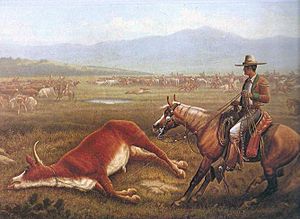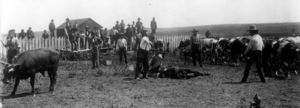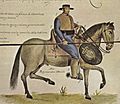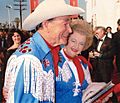Cowboy facts for kids
A cowboy (from the Spanish word vaquero) is a person who works with cattle and horses on large farms called ranches. Cowboys are found in North and South America. The cowboy who takes care of the horses is called a wrangler. Besides working on ranches, some cowboys also take part in exciting events called rodeos. Many cowboys even work only in rodeos. Movies about cowboys are often called western movies.
Contents
Cowboys Around the World
The idea of cowboys and working with cattle on horseback started in Spain. This way of life spread to many other countries.
- In Mexico, cowboys are called vaqueros.
- In Hawaii, they are known as paniolo.
- In Argentina, Uruguay, Paraguay, and southern Brazil, they are called gauchos.
- In Venezuela, they are the llaneros.
- In Chile, they are the huasos.
- In Australia, where ranches are called "stations," cowboys are known as jackaroos and cowgirls as jillaroos.
What Working Cowboys Do
On a ranch, a cowboy has many important jobs. They feed the animals, mark cattle and horses (called branding), and help animals that are hurt or sick. They also move livestock to different areas or to sell them at market. Cowboys also fix fences, take care of ranch tools, and do other helpful tasks around the ranch.
The jobs can change depending on how big the ranch is, what the land is like, and how many animals there are. On very large ranches, cowboys might focus on just one type of job. But on smaller ranches, cowboys often do many different tasks.
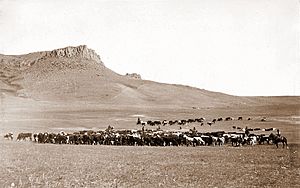
Cowboy Clothes
The special clothes cowboys wear, known as Western wear, were designed to help them do their jobs. Many of these items came from the Mexican vaqueros.
- Cowboy hat: This hat has a wide brim to protect from the sun and bad weather. There are many styles, often inspired by Mexican sombreros.
- Cowboy boot: These boots have a high top to protect the lower legs. They have pointed toes to help guide the foot into the stirrup and high heels to keep the foot from slipping through the stirrup while riding.
- Jeans: Cowboys wear strong, tight-fitting pants like jeans. These heavy pants protect their legs and fit snugly so they don't get caught on bushes or ranch equipment.
Cowboy Tools
Cowboys use several tools to help them with their work.
- Chaps: These are protective coverings worn over pants to shield the legs when riding through thick bushes or working hard with animals.
- Lariat: This is a strong, twisted rope with a loop at one end. It's used to catch animals and is sometimes called a lasso.
- Spurs: These tools are attached to boots and help a rider tell the horse what to do, especially when their hands are busy or it's too noisy for voice commands.
- Rifle: A rifle is used to protect livestock from wild animals. Sometimes, cowboys also carry a pistol when they are not actively working with cattle, especially in areas with lots of bushes.
- Cow dog: Many cowboys use herding dogs to help find and control livestock.
Cowboy Horses
Horses are very important on a large ranch because they can go where vehicles cannot. Horses, along with mules and donkeys, also carry supplies. A special horse called a "cutting horse" is very important for separating cattle. Since the rider is busy, the horse must be able to steer by just feeling the reins on its neck (called "neck reining"). It also needs "cow sense," meaning it knows how to guess what the cattle will do.
Here are some things used with horses:
- Western Saddle: This saddle is made for working with cattle. It has stirrups for the rider to stand in, a "horn" to tie the lariat to, and places to attach other equipment.
- Saddle blanket: A blanket or pad is placed under the Western saddle to keep the horse comfortable and protected.
- Bridle: A Western bridle usually has a special bit and long reins to control the horse.
- Saddle bags: These bags attach to the saddle and are used for carrying small items and extra supplies.
Ranch Vehicles
The most common vehicle on a ranch is the pickup truck. It's strong and roomy, with high ground clearance, so it can carry supplies from town and handle rough ranch trails. Pickup trucks are also used to pull trailers that move cattle and horses. Sometimes, motorcycles are used, but the most common small vehicle is the four-wheeler. It can quickly carry one cowboy around the ranch for small jobs. In places with a lot of snow, snowmobiles are also common.
Rodeo Cowboys
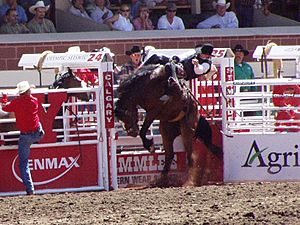
Long ago, there wasn't much difference between a working cowboy and a rodeo cowboy. The term "working cowboy" only became common in the 1950s. Early cowboys worked on ranches and showed off their skills during cattle roundups. The word rodeo comes from the Spanish word rodear, which means "to turn" or "roundup."
When professional rodeos started, cowboys, like other athletes, could earn money by showing their skills to an audience. Rodeos also created jobs for many working cowboys who were needed to handle the animals. Many rodeo cowboys have experience as working cowboys.
The clothes of a rodeo cowboy are similar to what a working cowboy might wear when going to town. However, the "cowboy shirt," which became popular from early movies, was specially made for rodeos. It often has snaps instead of buttons. This allows the cowboy to quickly get out of the shirt if it gets caught on the horns of a steer or bull.
Cowgirls
While cowgirls share many things with cowboys, their history is a bit different. There are no records of girls or women driving cattle on the old cattle trails. But many women certainly helped on ranches, and some even managed them. However, few regularly wore clothes suitable for working cattle from horseback.
Cowgirls really became famous with the start of Wild West shows. Their amazing riding, expert shooting, and trick roping entertained people all over the world. By 1900, skirts that were split for riding became popular. This allowed women to compete with men in many events. In the movies that followed, cowgirls became even more popular, and movie designers created attractive clothes for riding Western saddles.
Cowboys in Popular Culture
Because of the long history of the West in movies and stories, people often think of anyone wearing Western clothes as a cowboy or cowgirl, even if they've never ridden a horse. This is especially true for entertainers and public figures who wear Western clothing as part of their image.
Images for kids
-
An 18th-century soldado de cuera in colonial Mexico
-
An 1898 photo of a round-up in Colorado
-
A Cracker Cowboy by Frederic Remington
-
Loading cattle at Kailua-Kona, early 1900s.
-
Cattle drive in New Mexico
See also
 In Spanish: Vaquero para niños
In Spanish: Vaquero para niños


